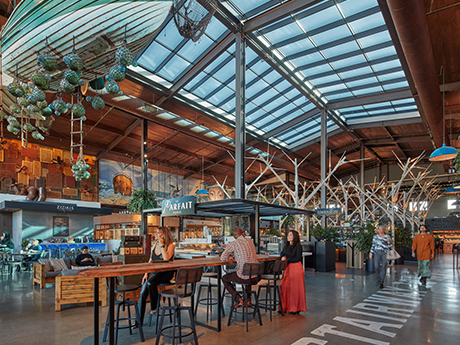Interview by Randall Shearin
As shopping centers evolve to have more experiential tenants, many owners and operators are looking at design as one way to convey experience to visitors. Adding open-air elements — public gathering spaces, parks, murals —has become popular. Centers are also more open to blending uses than creating retail districts.
To gain more insight on the efficacy of these practices and understand how they add value, Shopping Center Business recently interviewed Mitra Esfandiari, partner at Long Beach, California-based RDC, who has worked on a number of forward-thinking centers over the past decade. What follows are her edited responses:

Mitra Esfandiari, RDC
Shopping Center Business: How are center owners viewing design as an asset to their properties?
Mitra Esfandiari: As architects, we are continuously looking to the future, examining lifestyle, local cultural heritage and demographic trends to be sure we are creating human-centric and authentic places to meet the needs of the community. This approach creates a roadmap that leads the design process for creating experiential and memorable environments that will draw visitors and further entice them to stay longer and repeat their visits.
For the past decade, with the emergence of e-commerce and the recent disruptions of the COVID-19 pandemic, consumer needs have evolved rapidly and have had a direct influence on the built environment because of how people now live, work and play. The owners who have approached these disruptions as opportunities for innovation and creativity rather setbacks have been thriving.
RDC worked with Donahue Schriber (DSRG) on the $120 million repositioning and expansion of the open-air Del Mar Highlands Town Center to transform the existing center into a vibrant experiential shopping and entertainment destination. There was an innovative approach to creating an anchor such as The Sky Deck as a unique culinary destination that is beyond just offering food and entertainment. It is also designed for visitors to immerse themselves in multi-sensory experiences through architecture, interior design, curated art, lighting design and environmental graphics. This allows people to discover the story of the place and share these memorable experiences with others in person or through social media.
In addition, the large volume of the main space, with connectivity to outdoor patios and upper deck beer garden, has made this place a very popular hub for the community during the pandemic. DSRG completed the sale of Del Mar Highlands Town Center to current owner First Washington Realty in 2022.
SCB: When looking at how to improve their centers, what features are owners asking designers to incorporate?
Esfandiari: We have entered an era in which single-use environments do not respond well to the ways people desire to live, work and play. There is a continued shift towards mixed-use environments that bring diversity and a range of experiences for localized offerings, satisfy consumers’ needs for convenience and meet their daily needs with proximity to where they live.
For owners with existing shopping centers, incorporating varied uses such as residential, entertainment, office or health services within the development in ways that allow the new uses to integrate well into the local context is akin to meeting consumer needs and creating enriching communities. We see demand for integration of experiential retail and entertainment into mixed-use developments.
As a common approach, retail and entertainment venues are placed at the ground level with adjacent, amenitized open spaces and offer opportunities for indoor/outdoor experiences as ways of energizing sidewalks and creating a sense of community. In most cases, the area of retail is less than other uses; however it is a very critical component of the mixed-use development that ties the overall development into the local context.
The ground level with the direct link to the community sets the cultural tone of the development. We sometimes see these spaces end up being vacant for long periods of time, and this impacts overall perception of the whole development. We have seen great results when ownership, leasing teams and design teams work together from the beginning to set the vision of the project. This involves forming a leasing strategy for creating a tenant mix that responds to the needs of the community with inherent degree of flexibility for future changes.
In addition, creative architectural design of the retail façades/storefronts, lighting, environmental graphics, curated art and landscaping all contribute to the overall vision of the development. Considering brand identities of the tenants in order to create memorable experiences that lead to the success of the development is also key.
RDC is working with Texas Medical Center to integrate experiential retail and hospitality to the world’s largest medical campus called Helix Park at Texas Medical Center in Houston. This is to activate and humanize the ground level with a direct link into a chain of six parks in the shape of a double helix extending throughout this campus as fully curated and programmed gathering areas. The spaces for shops, various unique culinary destinations with outdoor patios, fitness centers, entertainment venues and public spaces are not only for researchers, doctors, professionals and visitors, but are also designed as a destination for bringing in the greater surrounding community and infusing energy of Houston’s diverse communities.
SCB: In your opinion, what design features of a shopping center are most effective at garnering attention and drawing traffic?
Esfandiari: While on-ine shopping provides convenience, ‘experiences’ that can’t be purchased online remain crucial components for success in brick-and-mortar retail. The desire for in-person human connections has led owners to provide carefully programmed open spaces with events and entertainment to create a sense of community, drawing traffic in the process. In addition, we learned firsthand during the pandemic how open space could be an invaluable asset during pandemic. We saw tenants adapt that indoor/outdoor feature to create a sense of safety for their customers.
At Del Mar Highlands Town Center, various public spaces are spread throughout the center as gathering nodes for the community. Also, adding a grocery store to a shopping center is a proven way to draw traffic. Currently, there is a demand for healthy, organic foods, specialty foods and prepared foods.
Erewhon is rolling out stores in California and incorporating them into existing properties. While these may not always be shopping centers, they may be urban streets. For example, Erewhon has recently added a store in Studio City at the Shops at the Sportsmen’s Lodge. This reinvention of a storied property adds the Erewhon among other contemporary lifestyle shops that attract local and regional shoppers.
— This article originally appeared in the February 2023 issue of Shopping Center Business magazine.


